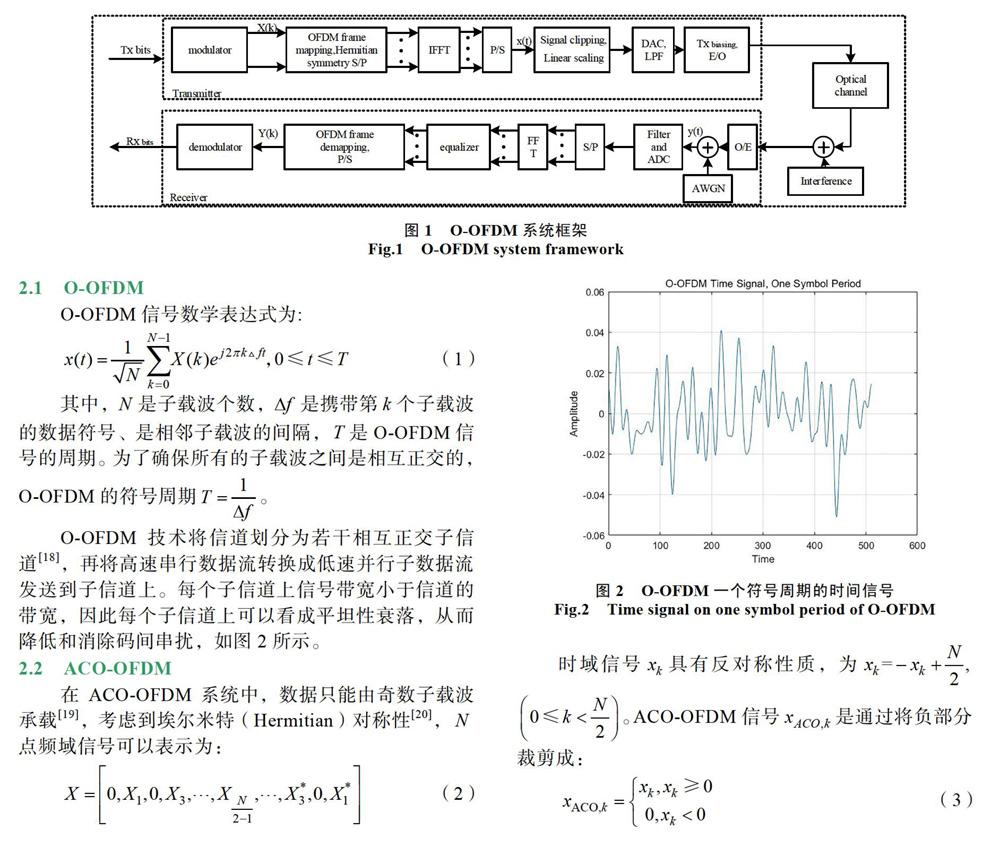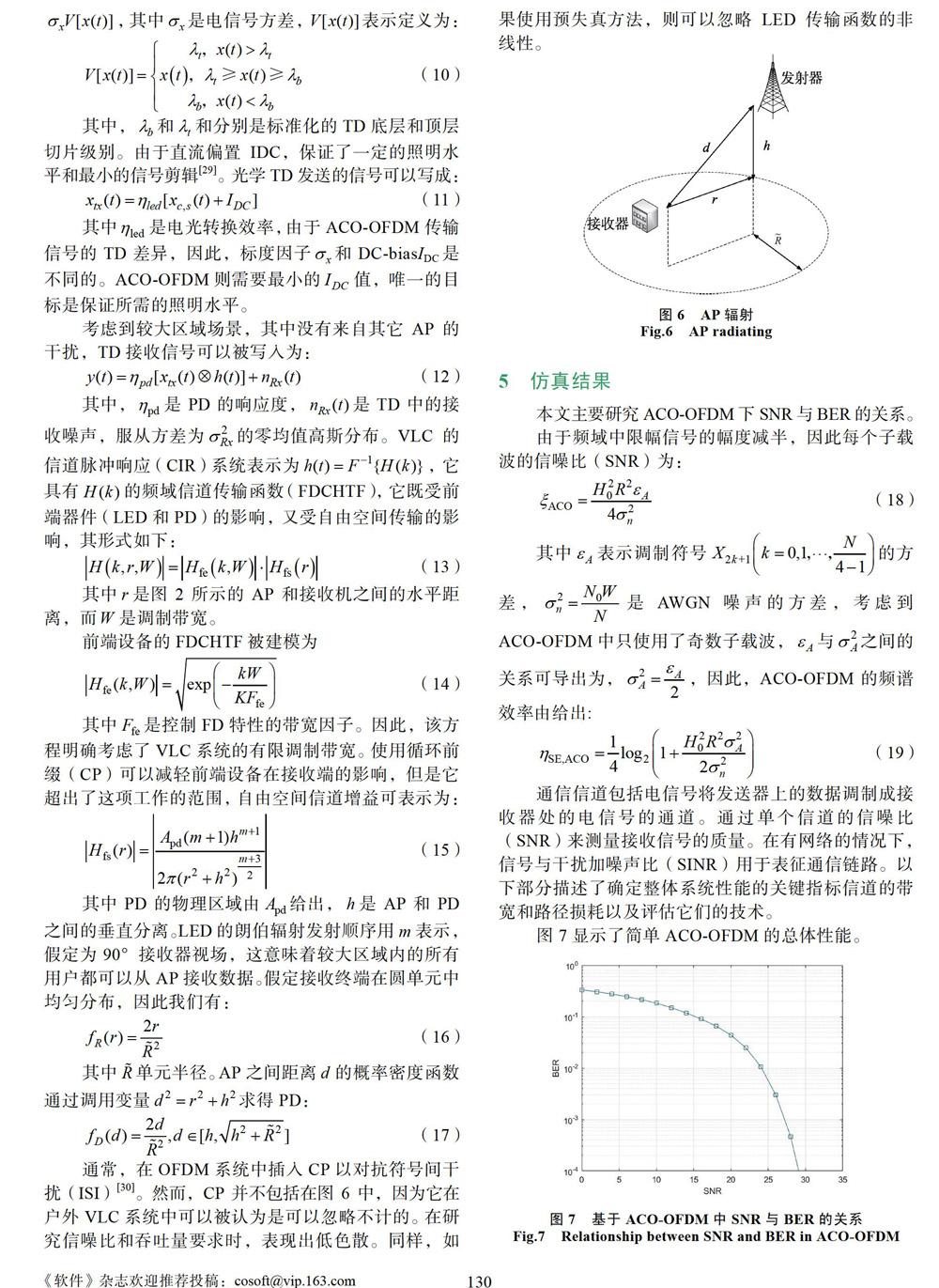基于Light Fidelity技术在智慧城市的应用
2020-12-14陈虹旭张斯妍李晓坤
陈虹旭 张斯妍 李晓坤



摘 要: 本文以Light Fidelity展趋势和概念为基础,通过研究Light Fidelity技术在智慧城市的应用,以推动智慧城市建设。Light Fidelity是一种以白光LED为基础的新型无线通信技术,主流的可见光通信系统采用光正交频分复用(O-OFDM)技术来实现,该技术可以使受到干扰的信号仍然能被可靠地接收,信号的频带利用率也大幅提高,非对称限幅光正交频分复用(ACO-OFDM)调制使得O-OFDM技术完全适用于可见光通信。本文讨论滤波器组多载波(FBMC)与O-OFDM在Light Fidelity通信过程中的性能对比,通过理论分析结合仿真说明具体分析,探讨FBMC及O-OFDM在通信过程中的指标比对,由此证明采用O-OFDM在Light Fidelity通信中的优越性。
关键词: Light Fidelity;智慧城市;O-OFDM;FBMC;SNR
中图分类号: TN929.12 文献标识码: A DOI:10.3969/j.issn.1003-6970.2020.09.035
【Abstract】: Based on the development trend and concept of Light Fidelity technology, this paper promotes the construction of smart cities by studying the application of Light Fidelity technology in smart cities. Light Fidelity is a new type of wireless communication technology based on white LED. The mainstream visible light communication system is realized by optical orthogonal frequency division multiplexing (O-OFDM) technology, which can effectively resist multipath interference and can be subjected to the interfering signal can still be reliably received, and the frequency band utilization of the signal is also greatly improved. Asymmetrically limited optical orthogonal frequency division multiplexing (ACO-OFDM) modulation makes O-OFDM technology fully suitable for visible light communication. Considering the serious impact of noise on ACO-OFDM, the BER and SNR based on ACO-OFDM are performed. The related research, through theoretical analysis combined with simulation to analyze the specific scheme involved, this paper focuses on the study of ACO-OFDM, through the dynamic bit allocation and dynamic subchannel allocation method, make full use of the sub-channel with high signal-to-noise ratio Light Fidelity technology provides powerful power in smart city applications.
【Key words】: Light fidelity; Smart city; O-OFDM, SNR
0 引言
智慧城市是利用新一代信息技术来感知、监测、分析、整合城市资源、对各种需求做出迅速、灵活、准确反应,为公众创造绿色、和谐环境,提供泛在、便捷、高效服务的城市形态[1]。Li-Fi使用的协议为IEEE802.15.7[4]。通常,通过控制LED对数据进行编码和传输,并将一个可以编码的控制器植入LED中,(其中1表示灯亮,0表示灯灭),利发光二极管(LED)快速响应的特性,形成类似于AP(WIFI热点)的设备,以人眼无法感知的高速明暗闪光信号作为信息载体,使携带信息的光信号通过传输介质[5]。最后,通过光电转换装置将接收到的光信号恢复发送的信息,该
技术具有广泛且免许可的频谱、不受管制的带宽、高安全性、传输速率高、不受电磁干扰、射频禁区内的可用性、高能源效率等优点,在未来的通信领域中占据重要的地位并产生深远影响[8]。
1 Li-Fi在智慧城市中的应用
Li-Fi在智慧城市中的主要应用集中在控制、通信和定位方面[9]。它将通信和照明结合起来,推动智慧城市建设。
1.1 智慧交通
在智慧交通领域中,数据通过交通信号灯传送到汽车之间,实现车辆收费管理、户外导航,隧道和地
下车库定位等功能,还可以通过交通信号灯和汽车灯之间的信息交换,准确定位,Li-Fi技术还能够减小交通事故和交通堵塞的发生,為未来的无人驾驶汽车奠定基础[11]。
1.2 智慧家居
将天花板灯改装成Li-Fi热点,家用电器上安装Li-Fi接收器,通过天花板灯将这些设备连接到互联网,在设置一个总开关控制各家用电器的运行[13]。由于Li-Fi的高保密性,可以有效避免黑客攻击[14]。
1.3 智慧物流
智慧物流是将物联网、大数据、云计算、人工智能等技术应用在物流系统中的运输配送等环节。
通过在道路的路灯和汽车灯上加装芯片来进行Li-Fi可见光通信,在交通堵塞等恶劣条件下,通过汽车灯与路灯之间传递信息,引导物流通行更加畅通[15]。由于Li-Fi技术的信息传输速度快,能够及时反馈物流信息,从而实现对货物的实时监控。
1.4 智慧医疗
在智慧医疗领域中,可见光没有电磁污染,可以在电磁干扰敏感的区域进行无线接入,不受设备干扰,覆盖范围广。手術室配有照明设备,所以Li-Fi可以在医疗设备之间使用,特别是在不适合射频无线通信的医疗环境中。Li-Fi的传输速率高,能够达到实时传输、实时监测等功能。
智慧医疗是采用新型物联网、传感器、通信等技术的医疗理念,相信在不久的将来,Li-Fi作为新型通信技术,将推动智慧医疗的繁荣发展。
2 O-OFDM技术
Li-Fi以LED可见光作为传输信息载体的一种通信方式,它不需要任何的有线传输媒介,就可实现语音、数据、多媒体图像等高速双向传输[16]。但光在空气中传输会产生多径效应,而正交频分复用技术(OFDM)由于它对多径信道的抗干扰能力可以有效解决这一问题,并且OFDM技术具有较高频谱利用率和传输速率[17]。
本文研究了光OFDM技术,即ACO-OFDM,图1是O-OFDM的系统框架。
2.1 O-OFDM
其中,是子载波个数,是携带第个子载波的数据符号、是相邻子载波的间隔,是O-OFDM信号的周期。为了确保所有的子载波之间是相互正交的,O-OFDM的符号周期。
O-OFDM技术将信道划分为若干相互正交子信 道[18],再将高速串行数据流转换成低速并行子数据流发送到子信道上。每个子信道上信号带宽小于信道的带宽,因此每个子信道上可以看成平坦性衰落,从而降低和消除码间串扰,如图2所示。
2.2 ACO-OFDM
在ACO-OFDM系统中,数据只能由奇数子载波承载[19],考虑到埃尔米特(Hermitian)对称性[20],点频域信号可以表示为:
3 FBMC调制原理
给出了具有偏移正交幅度调制的滤波器组多载波(FBMC/OQAM)收发信机的框图。FBMC/OQAM系统用于传输OQAM而不是QAM符号[22]。输入数据在发射机侧,并且时刻在第个子载波上用表示,(m:子载波指数,n:符号指数)。
4 系统模型
阐述了本研究所考虑的系统模型。输入比特映射到M元星座的正交幅度调制(QAM)符号,可知M根据SNR量化的信道条件而变化[26]。将一组K符号映射到ACO-OFDM方案的K个频域(FD)子载波。在ACO-OFDM中,符号映射到奇数FD子载波的前半部分,其指标为,令偶数子载波置零。在此方案中,FD子载波的信息设置为0,并且在FD子载波的后半部分上传输的信息()是相对于在前半部分中传达的信息的Hermitian对称(1到),这种排列方式使我们能够在逆快速傅里叶变换(IFFT)后[27],在时域(TD)得到一个实值输出信号。
6 实验结论
实验结果得出ACO-OFDM在数据速率方面提供了更好的性能。对于在智慧城市中的Li-Fi方案的实际应用,ACO-OFDM适合光的多径传播和多普勒频移的无线移动信道中传输高速数据,且信道利用率高。相较于新提出的FBMC,ACO-OFDM也在光通信中体现出更好的性能,频谱效率和功率谱密度方面都优于FBMC。ACO-OFDM能够更好应用于Li-Fi中。
7 结束语
智慧城市是未来城市发展的主要方向,Li-Fi技术在智慧城市中将发挥越来越重要的作用,Li-Fi技术在智慧城市各领域的应用也必将随着技术的进步和人们对智慧城市间认识的深入而更加广泛地应用,智慧城市、无线通信技术的蓬勃发展,将会催生新的经济增长点,促进物质文明和精神文明的进步,使中国新型城镇化向着健康、有序的方向发展。
参考文献
[1]Sanchez L, Mu?oz L, Galache J A, et al. Smart Santander: IoT experimentation over a smart city testbed[J]. Computer Networks, 2014, 61(6): 217-238.
[2]Hall R E, Bowerman B, Braverman J, et al. The vision of a smart city[J]. Office of Scientific & Technical Information Technical Reports, 2000.
[3]Jin J, Gubbi J, Marusic S, et al. An Information Framework for Creating a Smart City Through Internet of Things[J]. IEEE Internet of Things Journal, 2014, 1(2): 112-121.
[4]Tsonev D, Videv S, Haas H. Light fidelity (Li-Fi): towards all-optical networking[J]. Proceedings of SPIE-The Interna tional Society for Optical Engineering, 2014, 9007(5): 900702.
[5]Haas H. High-speed wireless networking using visible light[J]. SPIE Newsroom, 2013.
[6]Kalaiselvi V K G, Sangavi A, Dhivya. Li-Fi technology in traffic light[C]//International Conference on Computing & Communications Technologies. IEEE, 2017.
[7]Mahendran R. Integrated Li-Fi (Light Fidelity) for smart communication through illumination[C]//International Con fe rence on Advanced Communication Control & Computing Technologies. IEEE, 2017.
[8]Bialic E, Nguyen D C, Vaufrey D. LED dynamic electro- optical responses and light-fidelity-application optimi za tion[J]. Applied Optics, 2014, 53(31): 7195.
[9]Alawadhi S, Scholl H J. Aspirations and Realizations: The Smart City of Seattle[C]//System Sciences (HICSS), 2013 46th Hawaii International Conference on. IEEE, 2013.
[10]Batty, M. Big data, smart cities and city planning[J]. Dialogues in Human Geography, 2013, 3(3): 274-279.
[11]Xu B, Yu G, Dai J, et al. Li-Fi: Light fidelity-a survey[J]. Wireless Networks, 2004, 21(6): 1879-1889.
[12]Su K, Li J, Fu H. Smart city and the applica tions[C]// International Conference on Electronics. IEEE, 2011.
[13]Swami N V, Sirsat N B, Holambe P R. Light Fidelity (Li-Fi): In Mobile Communication and Ubiquitous Computing App lications[M]//Advances in Computing Applications. Springer Singapore, 2016.
[14]Singh S, Kakamanshadi G, Gupta S. Visible Light Comm uni cation-an emerging wireless communication technology[C]// International Conference on Recent Advances in Engineering & Computational Sciences. IEEE, 2016.
[15]Centenaro M, Vangelista L, Zanella A, et al. Long-range communications in unlicensed bands: the rising stars in the IoT and smart city scenarios[J]. IEEE Wireless Communi cations, 2016, 23(5): 60-67.
[16]Wei C C. Small-signal analysis of OOFDM signal transmis sion with directly modulated laser and direct detection[J]. Optics Letters, 2011, 36(2): 151-153.
[17]Nadal L, Svaluto Moreolo M, Fàbrega, Josep M, et al. Low complexity PAPR reduction techniques for clipping and quantization noise mitigation in direct-detection O-OFDM systems[J]. Optical Fiber Technology, 2014, 20(3): 208-216.
[18]Sun G, Wang R, Pu T, et al. Research of nonlinearity in OOFDM communication[C]//Optical Transmission Systems, Switching, and Subsystems VII. International Society for Optics and Photonics, 2009.
[19]Dissanayake S D, Armstrong J. Comparison of ACO-OFDM, DCO-OFDM and ADO-OFDM in IM/DD systems[J]. Journal of Lightwave Technology, 2013, 31(7): 1063-1072.
[20]Liu, Tao. A novel scheme for demodulation of ACO-OFDM in the presence of DC offset[J]. Journal of the Franklin Institute, 2015, 352(3): 802-812.
[21]Zhang T, Zhou J, Zhang Z, et al. A performance impro vement and cost-efficient ACO-OFDM scheme for visible light communications[J]. Optics Communications, 2017, 402: 199-205.
[22]Qu D, Lu S, Jiang T. Multi-Block Joint Optimization for the Peak-to-Average Power Ratio Reduction of FBMC-OQAM Signals[J]. IEEE Transactions on Signal Processing, 2013, 61(7): 1605-1613.
[23]Zhang H, Le Ruyet D, Roviras D, et al. Spectral Efficiency Comparison of OFDM/FBMC for Uplink Cognitive Radio Networks[J]. EURASIP Journal on Advances in Signal Pro ce ssing, 2010, 2010: 1-15.
[24]Shaat M, Bader F. Computationally Efficient Power Allo cation Algorithm in Multicarrier-Based Cognitive Radio Networks: OFDM and FBMC Systems[J]. EURASIP Journal on Advances in Signal Processing, 2010, 2010: 1-14.
[25]Medjahdi Y, M. Terré, Ruyet D L, et al. Inter-Cell Interference Analysis for OFDM/FBMC Systems[C]//IEEE Workshop on Signal Processing Advances in Wireless Communications. IEEE, 2009.
[26]Xu J, Xu W, Zhang H, et al. Asymmetrically Reconstructed Optical OFDM for Visible Light Communications[J]. IEEE Photonics Journal, 2016: 1-1.
[27]Asadzadeh K, Dabbo A, Hranilovic S. Receiver design for asymmetrically clipped optical OFDM. [C]//IEEE Globecom Workshops. IEEE, 2011.
[28]Mondal M R H, Faruque R B. Hybrid diversity combined OFDM for LiFi[C]//IEEE International Conference on Telecommunications & Photonics. IEEE, 2018.
[29]Alaka S, Narasimhan L T, Chockalingam A. Coded Index Modulation for Non-DC-Biased OFDM in Multiple LED Visible Light Communication[J]. 2015.
[30]Saengudomlert P, Panta J, Sripimanwat K. Optimal sizing of QAM constellation for indoor optical wireless OFDM transmissions without bandwidth limitation[C]//Electrical Engineering Congress. IEEE, 2014.
